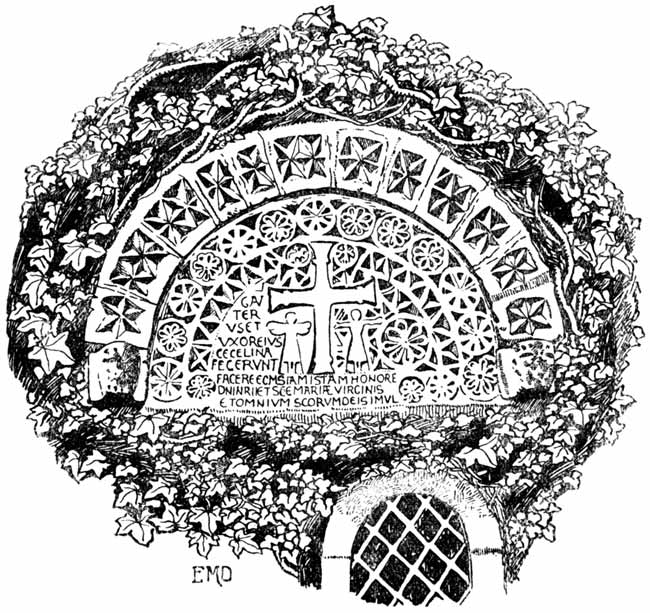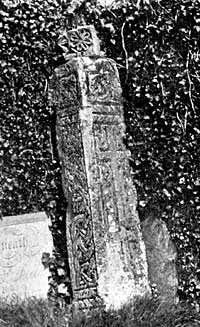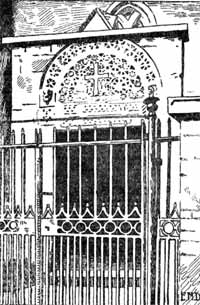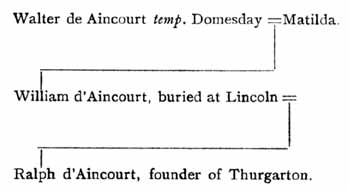Hawksworth

Tympanum, Hawksworth.
 Hawksworth Cross.
Hawksworth Cross.From Screveton the journey was continued to Hawksworth, where the Rev. J. G. Bayles met the members. The Church, dedicated to St. Mary and All Saints, is Early English, and has a nave, with clerestory, massive western tower, and chancel; rebuilt in 1851. There is a dedication stone and the remains of a churchyard cross. Mr. Phillimore described the stone, which is in the south wall, and read a translation to the effect that Gauterus and his wife, Cecilina, caused the Church to be built in honour of St. Mary the Virgin and All Saints. The Church has still the same dedication. There are crosses and figures on the stone, the latter emblematical of Saints, and an Agnus Dei. The following is the inscription—
GA/
TER
VS ET
VXOR EIVS
CECELINA
FECERVNT
FACERE ECMESIAM ISTAM IN HONORE
DNI NRI ET SCE MARIAE VIRGINIS.
ET OMNIVM SCORUM DEI SIMVL
The Extension—
GAUTERUS ET UXOR EJUS CECELINA FECERUNT FACERE ECCLESIAM ISTAM IN HONORE DOMINI NOSTRI ET SANCTAE MARIAE VIRGINIS ET OMNIUM SANCTORUM DEI SIMUL.
The Translation—
"Walter and his wife, Cecelina, caused this Church to be made in honour of Our Lord and of Saint Mary the Virgin, and of all God's Saints likewise."

This interesting tympanum is not in its original site, which appears to have been over the western doorway of the tower. We give a drawing of it in this position, and another on a larger scale in its present site. The word "ecclesiam" would seem to have been tampered with, as it reads ECMESIAM. We also reproduce as our frontispiece a photograph of the shaft of the cross.
It is much to be regretted that these interesting views are exposed to the weather. They might well be removed into the Church since they are no longer in situ.
Mr. Phillimore thought that Walter was a member of the de Aslockton family,* but Mr. W. Stevenson expressed his belief that he was one of the D'Eyncourts, and an interesting letter on the names was read from Mr. W. H. Stevenson, M.A., editor of the "Nottingham Borough Records." From this letter we are able to give the following extract:—"Gaitterus is the French form of Walter latinized, and it is somewhat late, for the name was Walter in the eleventh century, and Gwalter, or Gwauter, well on in to the twelfth. Finally, the W was dropped, so that it became Gauter (Mod. Fr. Gautier). It would be older if it read Gvalterus. The inscription is given by Thoroton—Walter de Eyncourt was the Domesday lord, but his wife was named Matilda. Another Walter died 14 Hen. II. 1168, which is more like the date of this inscription. Thoroton did not know his wife's name. Cecelina is a curious name. One would expect Cecilia, though ina is a fem. diminutive suffix."
The Aincourts are said to derive their names from a parish in the Vexin Normand, between Mantes and Magny, so called, the patronage of which was given by one of the descendants of Walter to the Abbey of Bec. The services of Walter d'Aincourt, whatever they may have been, were rewarded by the Conqueror with the gift of fifty-five lordships in England, of which Blankney, in Lincolnshire, was one, and was made by him the head of his barony. Of his origin and antecedents no more is known than of his actions. Contemporary history is extremely silent about him. We do not find him engaged in any combat, intrusted with any office, employed in any missive, founding or endowing any monastic establishment, or even witnessing a charter, and might well doubt his having ever existed, but for the enumeration of his possessions in Domesday, and the epitaph of his son William in Lincoln Cathedral, on a leaden plate, found in his grave in the churchyard there. From that we learn that he was a kinsman of Remi, or Remigius, Bishop of Lincoln, who, according to Taylor's list, contributed a ship and twenty knights, or men-at-arms, to the fleet of Duke William—a fact that leads one to the conclusion that the lucky Walter owed his barony to the good offices of the Bishop, and not to any merit of his own. His son William is stated in his epitaph to have been in some way descended from royalty "praefatus Willielmus regia stirpe progenitus." How provoking are these vague statements. The descent must have been through his mother, as the wording of the sentence expressly limits the honour to William, and not even her baptismal name is known to us. William died in the reign of Rufus [September 26th, 1087, to August 2nd, 1100=13 years], leaving a son and heir, named Ralph, who might have lived at Rolleston or Thurgarton in his grandfather's time, and was the founder of Thurgarton Priory [1114—1140, Thoroton, p. 302]. The male line here became extinct, in the twenty-first of Henry VI. [1442], by the death of Robert, uncle of William, last Baron d' Eyncourt, when Margaret and Alice, sisters of the said William, were found his heirs, and carried the estates into the families of Cromwell and Lovel (J. R. Planche, The Conqueror and his Companions, vol. ii., p. 237). See article on Crowle Stone, Bygone Lincolnshire, vol. i., p. 72 ; also article on the d'Aincourts, vol. ii., p. 3. This gives:—
 |
*Thoroton expressly states upon the authority of the Register of Thurgarton Priory that Walter de Aslockton (which family held the fee of D'Eyncourt) confirmed to the Canons of Thurgarton certain lands which they held of his fee in Hawksworth and Aslockton. The Newmarches also for a time had the advowson of Hawksworth. They bore for arms five red fusils in fess, and so did the Aslocktons. The D'Eyncourts used a fess dancette, and the similarity of arms points to a close connection between the three families, which further study of feudal Nottinghamshire may some day elucidate.
